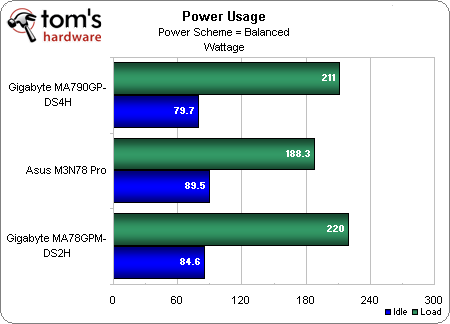AMD 790GX: RV610 For Enthusiasts?
Power Consumption

We ran our three test platforms using Vista’s three default power schemes to get a better idea of exactly how each one affected our results.
For our performance benchmarks, all tests were conducted in High-Performance mode, with the Phenom X4 9850 BE running at 2.5 GHz and all BIOS-related performance features disabled. In a real-world environment, however, your PC is likely idle more than loaded with work, making the Balanced or Power saver schemes attractive. Unfortunately, the Power saver plan handicaps performance as it helps cut back on energy use, so that one’s out too. Thus, we measured power consumption using the Balanced plan.
According to AMD, the 790GX incorporates four power-saving improvements that you wouldn’t get on a 780G board. The first is a deep sleep on the side-port memory, yielding up to 1.7 W of savings. Of course, since most 780G boards don’t have side-port memory, that’s a tough comparison to make. Driver and BIOS enhancements made to AMD’s PowerPlay technology purportedly save up to 3.1 W as well. Onboard voltage scaling is said to be worth another 900 mW and new support for the C1e power state approaches 6 W of savings. Yes, Intel has had C1e support for more than two years now. It’s a bit of surprise that AMD took so long to jump on board.
All told, AMD claims the potential for up to 12 W of savings. Our idle measurement was a bit less pronounced at 4.9 W versus Gigabyte’s 780G board with side-port memory. And compared to Nvidia’s GeForce 8300, the difference was closer to 10 W. Given Geoff Gasior’s findings (http://techreport.com/articles.x/14993/12) that the GeForce 8300 uses more power than AMD’s 780G at idle and load, we were surprised to see our Asus board using significantly less energy than either the 790GX or 780G running 3DMark Vantage and Cinebench R10.
Get Tom's Hardware's best news and in-depth reviews, straight to your inbox.
-
kitsilencer Great review, and it's good to see that AMD is at last able to target more enthusiast markets competitively.Reply -
cangelini kitsilencerGreat review, and it's good to see that AMD is at last able to target more enthusiast markets competitively.Reply
Thanks for the feedback Kit. -
waffle911 So... why does a page 15 and 16 of this article exist if there is no page 15 or 16 to the article?Reply
Take a closer look. What happened? -
YYD PCMark seems Intel biased, please read this:Reply
http://arstechnica.com/reviews/hardware/atom-nano-review.ars/6
Please change this benchmark suite or check if PcMark Vantage is unbiased. -
cangelini waffle911So... why does a page 15 and 16 of this article exist if there is no page 15 or 16 to the article?Take a closer look. What happened?Reply
That was strange. Should be fixed now.
-
cangelini YYDPCMark seems Intel biased, please read this:http://arstechnica.com/reviews/har view.ars/6Please change this benchmark suite or check if PcMark Vantage is unbiased.Reply
Fortunately, with no Intel platforms tested, this should be a non-issue for the current situation ;-) In the future, you'll be seeing SYSmark, though. -
Seems past page 8 or something the links are corrupt.. can't fully read this article and getting error 404 - page not found.Reply
-
cangelini lacrits.. and now the article seems to be removed even from the main page!?!?!Reply
Alright, mystery solved. It's back up, sans the blank page. Thanks for pointing that out lacrits!
